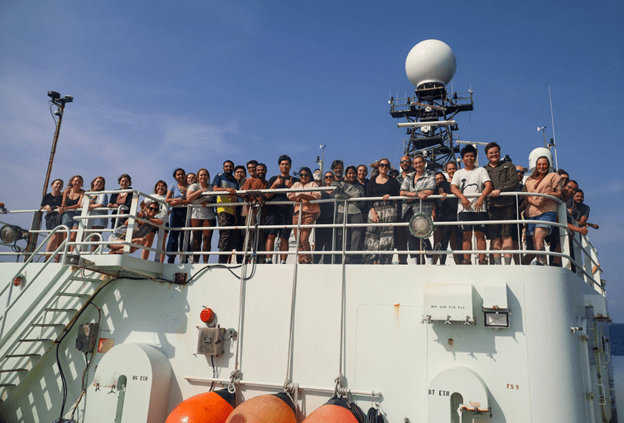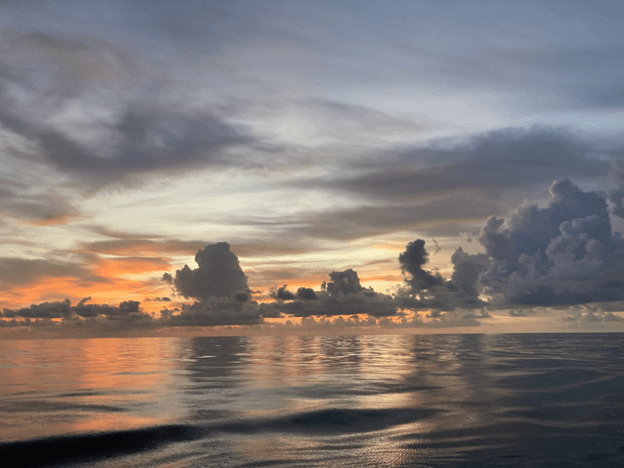by Katy Abbott
This summer, I got the opportunity to spend six weeks at sea in the Bay of Bengal during the Southwest Monsoon. Although I have studied wind-driven processes in this region during my PhD, it is one thing to make plots of high wind stress from the comfort of a desk on land — and another thing entirely to experience it firsthand in the middle of the ocean.

The TN-445 science party aboard the R/V Thompson, on a beautiful sunny day during a break in the monsoon! Image courtesy of Katy Abbott.
The cruise took place on the R/V Thompson, a global-class UNOLS research vessel operated by the University of Washington. Our science party was a powerhouse team of marine microbiologists, chemical oceanographers, isotope biogeochemists and, yours truly, a humble physical oceanographer. The primary science mission, led by chief scientists Annie Bourbonnais (University of South Carolina) and Maria Pachiadaki (WHOI), was to study nitrous oxide (N2O) production and nitrogen cycling in oxygen deficient zones, or ODZs. ODZs are regions of the ocean where oxygen concentrations are low (“hypoxic”) or even undetectable (“anoxic”). Under these low oxygen conditions, nitrate is used as a substitute electron acceptor for microbial respiration, in a process called denitrification. During the denitrification process, N2O, a powerful greenhouse gas, is produced. Studies predict that ODZs will expand under a warming climate, so it is important to quantify rates of N2O production and understand the pathways by which it is produced. To study this, our science party employed a suite of methods including in situ and shipboard rate measurements, incubation experiments and filtration of large volumes of water from Niskin bottles.
There are several physical and biological processes responsible for the formation of ODZs. They are often associated with highly productive coastal upwelling systems, because remineralization of the productive organic matter by microbes consumes oxygen in the process. However, coastal upwelling in the Bay of Bengal is relatively unproductive. Instead, the ODZ here is thought to be a consequence of weak vertical mixing in the basin. The Bay of Bengal is strongly stratified, and a thick lens of freshwater at the surface inhibits mixing of oxygen-rich surface water into the interior. Below about 75-100 m, oxygen concentrations sharply decrease and drop to nearly zero.
There are still many avenues for oxygen to make its way into the oxygen-starved ODZ — including small-scale eddy processes that mix and stir properties along density surfaces. In my research, I study interactions between these eddy processes, which transport surface organic carbon and oxygen to the interior ocean, and the microbes that consume this carbon and oxygen. One important parameter for my work is the respiration rate, which measures how quickly microbes use oxygen to oxidize organic carbon. During this cruise, I measured the respiration rate across a range of oxygen concentrations, which will allow us to understand how rapidly the oxygen that is supplied by eddy processes is “used up”.
Sampling during the monsoon comes with its challenges. Even on a large research vessel like the Thompson, many of us spent the first week or more getting over seasickness as a result of the high wind and waves. Weather delays were prevalent. But as a physical oceanographer, getting to observe the summer monsoon at sea was also a dream come true. In the Bay of Bengal, the monsoon is characterized by active phases — with strong winds, atmospheric convection and high precipitation — and break phases, where the winds die down. This variability occurs on 10-60 day timescales.
We left port right in the middle of an active phase, with a long transit to the northern bay. I spent a lot of the transit time in the CTD control room and out on deck, watching as we passed through atmospheric cold pools that showed up as sudden drops in air temperature in the meteorological data and the huge gusts of wind and bursts of rain on the back deck. Over the next six weeks, we witnessed some dramatic weather changes, including the transition from an active to break phase, where the skies cleared and the ocean was as calm as I have ever seen it, and the switch back to another active phase that was made especially stormy with the remnants of Tropical Storm Wipha rolling through the bay.

Convective clouds during a sunset at sea. Image courtesy of Katy Abbott.
Because the CTD was being deployed nearly around the clock, we were able to observe changes in the upper ocean structure directly linked to these meteorological processes we were experiencing. For me, this is one of the many thrills of seagoing oceanography that never gets old. Six weeks is a long time to be at sea. But there’s something remarkable about getting to do science in an environment like this — every day, you wake up and learn a little more about the secrets that the ocean contains.
